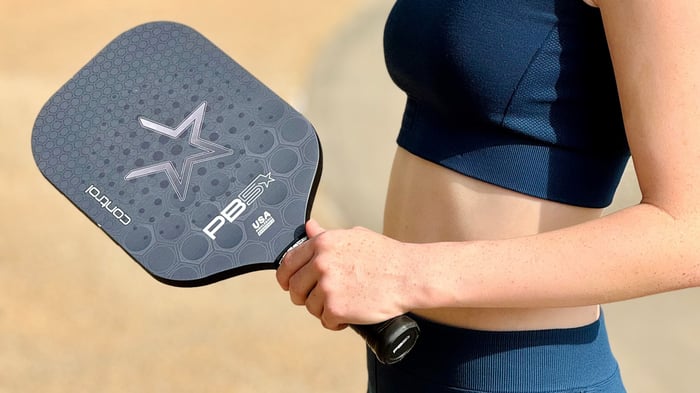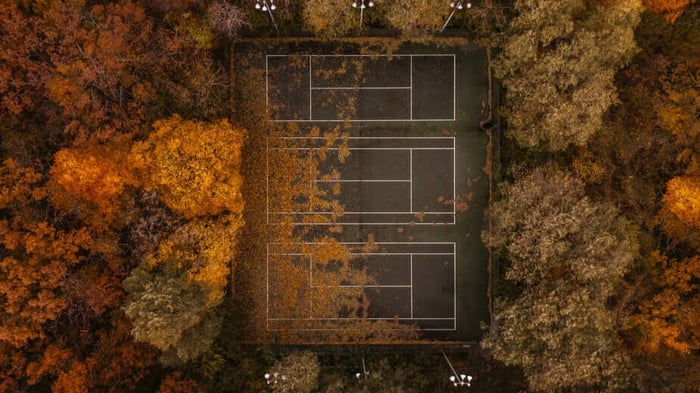Key Takeaways:
Pickleball can be played in two formats: singles (two players) and doubles (four players), each offering unique benefits and challenges.
Understanding the player configurations is essential for fully embracing the pickleball experience and optimizing your gameplay.
Pickleball is a sport that’s easy to learn, fun to play, and welcoming to all skill levels. But if you're new to the court, you might be wondering: how many players does a game of pickleball actually need?
The simple answer: it depends. Pickleball can be played as either singles (two players total) or doubles (four players total). Each format offers a unique pace, strategy, and social experience. Whether you’re chasing a solo challenge or craving the camaraderie of a team, there’s a version of the game for you.
In this guide, we’ll break down the singles and doubles formats, explain how the game plays out in each, and help you decide which one suits you best. We’ll also explore how PB5star gear supports your performance across both styles—so you can step on the court feeling ready, confident, and stylish.
Understanding the player formats in pickleball
There are two official formats in pickleball: singles (2 players total) and doubles (4 players total). Both are played on the same size court—20 feet wide by 44 feet long—and follow similar rules with just a few key differences.
Singles is a fast-paced one-on-one game that emphasizes endurance, speed, and sharp reflexes. It’s ideal for players who enjoy covering the court solo and testing their individual skills.
Doubles is a team-based game where two players work together on each side of the net. It encourages communication, coordination, and strategy, making it a favorite for social play and casual matches.
Let’s take a closer look at both formats to understand how they differ—and why players love each one for different reasons.
What to expect in singles pickleball
Singles pickleball is fast-paced and physically demanding. It’s a one-on-one game that pushes your reflexes, movement, and decision-making to the limit. With only two players on the court, there's no partner to back you up—every point is on you. Here’s what to expect when stepping into a singles match, along with the specific rules that guide play.
You cover the entire court
In singles, each player is responsible for the entire side of the court. That’s 20 feet wide and 44 feet long. Because there's more ground to cover, players need strong footwork, speed, and stamina. Quick lateral movement, sharp turns, and the ability to recover between points are essential. Unlike doubles, there’s no division of responsibility—every shot is yours to chase.
Singles serving rules
Serving in singles follows the same foundational rules as doubles, but with one key difference: there’s no partner rotation. Players serve from:
The right-hand side of the court when their score is even (0, 2, 4, etc.)
The left-hand side when their score is odd (1, 3, 5, etc.)
The serve must be hit underhand and diagonally cross-court, landing in the opponent’s service box. If the serve lands out of bounds, hits the net and doesn’t land in the correct area, or violates the underhand motion rule, it’s a fault and the serve goes to the opponent.
In singles, there's no "second server" per team. You keep serving as long as you win points on your serve. When you lose a rally while serving, the serve goes directly to your opponent.
The two-bounce rule still applies
Just like in doubles, singles games follow the two-bounce rule. This means:
The ball must bounce once on the receiving side after the serve.
The return shot must also bounce once on the serving side before the ball can be volleyed (hit out of the air).
After this exchange, both players are free to volley or groundstroke as needed.
Expect longer rallies and deeper shots
Singles pickleball often features longer rallies compared to doubles. Without a partner to cut off balls at the net, players are forced to rely on groundstrokes and strategic placement to win points. Deep baseline shots, sharp cross-court angles, and well-timed drop shots are common tactics.
Because players must reset to the middle of the court quickly, they tend to stay farther back and use the full length of the court. This results in more back-and-forth exchanges and a more physical game.
Court positioning matters
Maintaining good court position is crucial in singles. Players often stay near the baseline or just behind the kitchen line (non-volley zone) after hitting a shot. From there, they can react to deep drives or move forward for shorter balls. Staying too close to one side can leave the opposite side wide open, so quick recovery and neutral positioning after each shot are important.
It's a mental and tactical challenge
Singles is not just physical—it’s a test of your mental game. Each point requires focus, split-second decision-making, and the ability to read your opponent’s body language and shot selection. You’ll need to:
Recognize patterns in your opponent’s play
Vary your own shot selection
Choose the right moments to attack or defend
Stay calm under pressure and manage fatigue
Players who excel in singles often have strong court awareness, solid fundamentals, and the ability to adapt their strategy mid-game.
Scoring in singles
Scoring in singles follows standard pickleball scoring rules:
Games are typically played to 11 points, win by 2
Only the serving player can score points
The score is called as two numbers: your score followed by your opponent’s score
There’s no third number like in doubles (which refers to the server number), since there’s only one server per side in singles.
What to expect in doubles pickleball
Doubles pickleball is the most popular format of the game. Played with four players—two on each side—it emphasizes teamwork, communication, and strategic coordination. While the rules of the game are nearly the same as in singles, the dynamics shift significantly when you're sharing the court with a partner.
You split the court with a partner
In doubles, each team divides the court laterally. Each player generally covers one side, which reduces the total area each person needs to defend. With two players covering the 20-foot width, this format allows for better positioning, quicker reactions at the net, and less physical strain compared to singles.
That said, players still need to move cohesively. Shuffling laterally, covering for each other’s gaps, and switching sides smoothly are part of the game’s rhythm.
Serving rules in doubles
The doubles serving sequence is slightly more complex than singles. Each team gets two serves per turn—one for each player—except at the start of the game, where only one player on the first serving team serves.
The serving team follows this pattern:
The first server (on the right side) begins the rally.
If they win the point, they switch sides with their partner and continue serving.
If they lose the rally, the second server serves from their current position.
When both players lose their serves, it’s a side-out and the opposing team gains control of the serve.
Scoring in doubles
Doubles games are typically played to 11 points (win by 2), and points can only be scored by the serving team. The score is announced as a three-number call:
Your team’s score
Opponent’s score
Server number (either 1 or 2)
Example: “4–2–1” means your team has 4 points, the opponents have 2, and it’s the first server’s turn.
Teamwork and communication are essential
Doubles play relies heavily on how well you and your partner function as a unit. Good communication helps avoid unforced errors like both players going for the same shot or neither taking it. Key elements include:
Calling out shots (e.g., “mine” or “yours”)
Signaling poaching strategies (where one partner crosses over to intercept)
Using hand signs when stacking (a strategy often used to optimize court positioning for players with preferred sides)
Partners also need to stay mentally in sync—supporting each other after errors, maintaining a game plan, and adjusting strategies together.
You need smart positioning
Unlike singles, where speed and stamina dominate, doubles rewards precise positioning. The team that controls the non-volley zone (NVZ)—commonly called the kitchen—often controls the point.
Positioning tips include:
Advancing to the kitchen line together after a return
Avoiding gaps between players
Maintaining side-by-side or staggered formations depending on the rally
Soft shots like dinks and third-shot drops are key in doubles. These neutralize hard hitters and slow the pace to allow for better positioning. Effective doubles teams focus on shot placement, not just power.
Everyone gets their moment
Doubles play is more balanced in terms of court coverage and skill distribution. Each player contributes by:
Serving and returning
Holding the line at the net
Setting up offensive or defensive shots
It’s common for one player to be stronger at the baseline and the other at the net. With practice, teams can leverage these strengths through coordinated tactics.
Doubles strategies to know
As players get more advanced, they often use the following doubles strategies:
Stacking: Rearranging player positions to keep forehands in the middle or maintain a preferred side for each partner.
Poaching: One partner crosses over to take a shot on the other’s side—often done at the net to surprise the opponent.
Third shot drop: A soft, arcing shot hit after the serve return to drop into the kitchen and give the serving team time to advance.
These techniques are legal and common in competitive doubles play.
Which format should you play?
There’s no wrong answer—only what suits your style and goals.
Choose singles if you want a solo challenge, cardio workout, or a way to test your personal skill set.
Choose doubles if you enjoy social play, strategic teamwork, and shared fun on the court.
Many players enjoy both formats and switch between them depending on the day, the group, or their energy levels. Trying both will help you become a more complete player.
What about mixed doubles?
Mixed doubles is another popular version of pickleball doubles. It involves one male and one female player on each team. Mixed doubles is a staple in competitive play and offers a great dynamic for couples, friends, or any duo who wants to take on the court together.
The rules are the same, but strategies might shift depending on player strengths, shot styles, and court coverage plans.
Pickleball is for everyone
Whether you’re playing singles or doubles, pickleball delivers an exciting, inclusive experience that’s drawing more players every day. It’s a game of strategy, movement, and heart—and it’s meant to be shared.
Looking to step up your game? PB5star gear is made for players who care about style, performance, and community. Explore our latest apparel and equipment to find what fits your game best.
Because in pickleball, it’s not just about how many players are on the court—it’s about how you show up.







